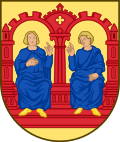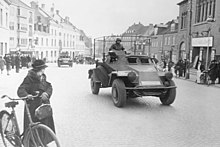Viborg
| Viborg | ||||
|
||||
| Basic data | ||||
|---|---|---|---|---|
| State : |
|
|||
| Region : | Midtjylland | |||
|
Municipality (since 2007) : |
Viborg | |||
| Coordinates : | 56 ° 27 ' N , 9 ° 25' E | |||
|
Population : (2020) |
40,778 | |||
| Postal code : | 8800 | |||
| Sister cities : |
|
|||
| Website: | www.viborg.dk | |||
 Viborg Cathedral |
||||
Viborg is a Danish city in the Midtjylland region. The administrative center of the region is located in Viborg. Viborg is also the center of the Viborg municipality . The urban area has 40,778 inhabitants, the municipality 96,921 inhabitants (as of January 1, 2020).
The city was originally called Vibjerg , which roughly means “the consecrated place on the heights” in Old Norse . In the Middle Ages, Vibjerg became Viborg .
geography
Viborg is inland, just a few kilometers from the geographic center of Jutland . The area around the city is a hilly moraine landscape. A few kilometers west of Viborg you can find the so-called ice line from the last ice age , further west the landscape is formed by meltwater deposits. Viborg marked a traffic junction early on. Roads from the north ( Aalborg , Løgstør ), the west ( Holstebro , Skive ) and the east ( Randers , Hobro ) converge here to this day, and continue in the so-called Ochsenweg to the Danish-German border and further through Schleswig-Holstein to Hamburg . The old port of Viborg was 10 km north at Hjarbæk. From here ships used to be able to get through the Limfjord to Aalborg and from there into the open sea.
history
A founding date of the city of Viborg is not known. In the Icelandic saga about Gisli Sursson it is mentioned that Gisli and two companions came to Viborg in 961 and spent the winter in the house of a man named Sigurdhaddur before they went back to Iceland. Since the saga was not written down until the 12th century, this information cannot serve as a proof of the age of the city. Archaeological remains of several farms from the Viking Age have been found in the old part of town . H. the 9th century - found. Around the year 1000 a street was built where the Store Sct. Peders Stræde (Great Saint Peter Lane) is located. At the same time the first church was probably built. In 1060 Jutland was divided into dioceses and Viborg was a bishopric. A few years later construction began on the cathedral, probably on the site of a pagan sanctuary.
Viborg soon became the meeting place of the Landsthing for Northern Jutland. At this popular assembly, among other things, the kings were honored, laws were negotiated and judgments were held. Viborg was thus the ecclesiastical and political center of power in Jutland in the Middle Ages . In the Middle Ages, Viborg had five monasteries and twelve parish churches in addition to the cathedral and cathedral chapter. In 1529 the Lutheran Reformation was introduced in Viborg, shortly afterwards the monasteries and parish churches were released for demolition by the king. Only the Dominican Church (Sortebrødre Kirke) and part of the Franciscan monastery remained. When absolutism and hereditary kingship were introduced in Denmark in 1660 , the Landsthing lost its influence and the city lost its importance. The Landsthing was dissolved as a political institution in 1806 and replaced by a higher regional court. In 1726 Viborg was struck by a devastating fire. Half of the city, including the cathedral and town hall, fell to rubble. Only after more than a hundred years did the city recover to some extent from this catastrophe. With the connection to the Danish railway network in 1863, the economic revival of Viborg began.
During the Second World War, Viborg was occupied by troops of the German Wehrmacht.
Viborg today
Viborg has remained a city with many public institutions and numerous officials to this day. It is the administrative seat of the municipality of Viborg and the Midtjylland region and the seat of Vestre Landsret, the court of appeal for Jutland. Viborg is still the seat of an Evangelical Lutheran bishop. The National Archives for North Jutland can also be found here. Since 2001 Viborg is no longer a garrison town. A training center has been built on the site of the former barracks, in which the city's numerous secondary schools have been housed. The media school that trains for film and television is well known.
Economy and Infrastructure
In the late 19th century, Viborg became a location for the textile, tobacco and food industries. Today these branches of industry have largely disappeared and have been replaced by metal processing companies (construction of wind turbines and cooling units). Viborg's economy is growing mainly in the service sector.
Companies
Genan , the recycling specialist for scrap tires, has its headquarters in the city. The company Hedeselskabet (dt. Heidegesellschaft), which is a leader in Danish forestry and the maintenance of green spaces and employs 1,000 people, has its headquarters in Viborg.
traffic
The main roads A13 (Aalborg - Vejle ) and A16 (Randers - Holstebro) cross in Viborg . Viborg has a station on the Langå – Struer railway line . In Langå this has a connection to the Randers – Aarhus railway line and on to Copenhagen and Padborg . There is a flight connection to Copenhagen from Karup Airport, 25 km southwest of the city.
Sights in and around Viborg
- Viborg Cathedral with frescoes (1901–1906) and oil paintings by Joakim Frederik Skovgaard
- Sortebrødre Kirke (former Dominican church). Altar with wood carving from the 16th century
- Hans Tausen Memorial Park with monuments by Hermann Ernst Freund and Bjørn Nørgaard . The reformer Hans Tausen preached in Viborg in 1525.
- Viborg Museum (local history museum) on Hjultorvet
- Skovgaard Museet . Art museum in the Old Town Hall, mainly for the Skovgaard family, artists in four generations
- Houses in the Sct. Mogens Gade, 16th to 18th centuries
- Town hall, built in 1728 according to plans by the Altona city architect Claus Stallknecht
- Homage monument , Sct. Mogens Gade
- Søndermarkskirken. Modern round church by the local architect Svend Frandsen from 1981. An enormous scallop shell serves as the baptismal font .
- Hald Sø (castle ruins) and Dollerup Bakker, scenic part south of the city
- Limestone pits in Mønsted and Daugbjerg
- Energimuseet. Electricity museum in Bjerringbro-Tange, 20 km away
- Bigum passage grave is located 20 km northeast.
Sports
Viborg is particularly well represented in handball. The women's team of Viborg Håndbold Klub (VHK) has been Danish champions several times and won the EHF Champions League three times (2006, 2009, 2010).
Every year in June in Viborg there is a great popular hike, the Hærvejsmarchen (ox trail march).
Town twinning
-
 Lueneburg , Lower Saxony
Lueneburg , Lower Saxony
-
 Hamar , Norway
Hamar , Norway
-
 Lund , Sweden
Lund , Sweden
-
 Porvoo , Finland
Porvoo , Finland
-
 Dalvíkurbyggð , Iceland
Dalvíkurbyggð , Iceland -
 Marijampolė , Lithuania
Marijampolė , Lithuania
-
 Kecskemét , Hungary
Kecskemét , Hungary
Personalities
sons and daughters of the town
- Niels Aagaard (1612–1657), Danish writer and scholar
- Christen Aagaard (1616–1664), Danish poet
- Christian Christopher Zahrtmann (1793-1853), Danish Vice Admiral and Minister of the Navy
- Jesper Jespersen von Bahnson (1827–1909), Lieutenant General and Minister of War
- Benjamin Christensen (1879–1959), silent film director
- Olaf Wieghorst (1899–1988), emigrated to America, where he became known as the painter of the wild west
- Aage V. Reiter (1901–1982), Danish poet
- Laurits “Lasse” Winsløw Nielsen (1911–2006), Danish painter, sculptor and graphic artist
- Johan Otto von Spreckelsen (1929–1987), architect, known for the new triumphal arch in Paris
- Ann-Marlene Henning (* 1964), psychologist, author and television presenter
- Frank Hvam (* 1970), actor and comedian
- Morten Lund (* 1972), jazz musician
- Christina Scherwin (* 1976), track and field athlete
- Rikke Skov (* 1980), handball player
- Ann Grete Nørgaard (* 1983), handball player
- Rasmussen (* 1985), actually Jonas Flodager Rasmussen, singer
- Anders Primdahl Vistisen (* 1987), politician
People with a relationship to the city
- Sankt Kjeld (12th century), Provost of the Cathedral, canonized in 1188
- Gunner (1152–1251), bishop, co-author of the Jutian law
- Claus Stallknecht (1681–1734), master builder for the reconstruction of the city
- Hans Christian Cornelius Mortensen (1856–1921), ornithologist, introduced the scientific ringing of migratory birds
- Peter Seeberg (1925–1999), writer, museum director
- Peer Hultberg (1935–2007), writer, psychoanalyst, grew up in Viborg
- Ulrik Wilbek (* 1958), handball trainer at Viborg HK
Literature and Sources
- Unknown author: Die Viborger , satirical mocking poem in: Fliegende Blätter , Volume 1, Book 2, p. 13. 1844.
- Henning Ringgaard Lauridsen (Ed.): Viborgs historie . Viborg 1998, ISBN 87-986605-0-0 .
- Svend Sørensen: Viborg and surroundings . Copenhagen 1997, ISBN 87-14-20545-9 .
Individual evidence
- ↑ a b Statistics Banks -> Befolkning og valg -> BY1: Folketal January 1st efter byområde, alder og køn (Danish)
Web links
- Official website of the city (Danish)
- History of Viborg (Danish)
- Skovgaard Museum ( Memento from April 28, 2003 in the Internet Archive )



